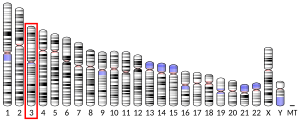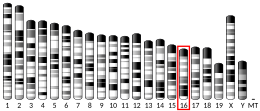OX-2 membrane glycoprotein, also named CD200 (Cluster of Differentiation 200)[5] is a human protein encoded by the CD200 gene.[6] CD200 gene is in human located on chromosome 3 in proximity to genes encoding other B7 proteins CD80/CD86. In mice CD200 gene is on chromosome 16.[7]
The protein encoded by this gene is a type-1 membrane glycoprotein, which contains two IgSF immunoglobulin domains, transmembrane region and a 19 amino acid long cytoplasmatic domain. CD 200 belongs to the immunoglobulin superfamily, particularly belongs to the B7 receptor family. [7][6]
Expression
editCD200 is expressed on dendritic cells, activated B lymphocytes, activated T lymphocytes, thymocytes, endothelial cells, neurons and osteoblast precursors. Moreover CD200 is expressed on various types of human cancer cells including hairy cell leukemia, acute myeloid leukemia, chronic lymphocytic leukemia, malignant melanoma, multiple myeloma, testicular cancer, renal carcinoma, colon carcinoma and glioblastoma multiforme.[7][8]
In innate immunity cells CD200 expression is induced upon TLRs and NLRs activation.
At the transcriptional level, CD200 expression is regulated by C/EBP-β. It was shown that CD200 expression is induced by IFN-γ and TNF-α in a NF-kappaB, STAT1 and IRF-1 dependent manner[7]
Soluble form
editSoluble CD200 (sCD200) is present in serum. It was shown that elevated levels of serum sCD200 are associated with adverse tumor prognosis in chronic lymphocytic leukemia, glioblastoma multiforme, ependymoma and medulloblastoma. Furthermore, sCD200 is associated with the expansion of myeloid-derived suppressor cells in patients with glioblastoma multiforme.[8]
Truncated form
editTruncated CD200 (CD200tr) is a truncated version of CD200 produced by alternative splicing mechanism. CD200tr lacks approximately 30 amino acids in the NH2-terminal sequence. It was shown that CD200tr acts as a competitive inhibitor to the full length CD200.[7]
Function
editCD200 interacts with its receptor CD200R and leads to immunosuppressive signaling. CD200R is strongly expressed on macrophages, neutrophils and mast cells as well as on some subtypes of B lymphocytes and T lymphocytes. In the tumor microenvironment CD200R is expressed on tumor-associated myeloid cells, particularly in tumor-associate macrophages, myeloid-derived suppressor cells, tumor-associated dendritic cells and also in regulatory T lymphocytes.[9][8]
CD200-CD200R engagement inhibits T-cell immune response, shifts cytokine profile towards Th2 type response, decreases NK cell cytotoxic activity, promotes indoleamin-2,3 dioxygenase production in macrophages and triggers regulatory T cell expansion. CD200 on dendritic and lymphoid effector cells modulates the activation threshold of inflammatory response and thus contributes to the maintenance of self-tolerance.[7][10] Interaction between CD200 and CD200R results in a down-regulation of basophils function and inhibits lytic function of NK cells. In IFN-γ and TNF-α producing macrophages, CD200-CD200R interaction leads to inhibition of function through Dok2 and RasGAP dependent mechanism. Elevated expression of CD200R on macrophages is associated with alternative activation of macrophages to M2 phenotype.[7]
Mechanism of action
editThe engagement of CD200 to CD200R leads to tyrosine phosphorylation on CD200R cytomplasmatic PTB domain. This leads to a recruitment of adaptor proteins DOK-1 and DOK-2 that promotes binding of SHIP to DOK-1 and the recruitment of RasGAP which negatively regulates the MAPK/ERK signaling pathway. This signaling leads to the inhibition of proinflammatory cytokine release and inhibition of immune cell activation and suppression of mast cell degranulation.[8]
Clinical significance
editPathogens modulate CD200-CD200R axis
editCD200-encoding gene has been acquired by a number of viruses infecting animals as well as human, for example some human herpesviruses.
KSHV, also known as human herpesvirus-8 is, essential for the development of Kaposi sarcoma. This virus produces an ortholog of CD200, known as viral OX2 (vOX2), a 55 kDa protein. This gene is expressed on the surface of infected cells during viral replicative state. vOX-2 has an approximately 40% sequence similarity with the human gene for CD200 but shares key residues with CD200 in its binding site for CD200R. Due to its ability to engage CD200R, vOX2 can target host immune cells (T lymphocytes, macrophages, neutrophils, basophils) and inhibit anti-viral activity. Particularly, vOX2 is capable of decreasing production of TNF-α, IFN-γ from macrophages and T lymphocytes and the CD170a-dependent activation of NK cells.
Leishmania amazonensis induces expression of CD200 in the bone marrow macrophages a thus inhibits neighboring macrophages expressing CD200R that inhibits NO production during infection. Infection with Taenia crassiceps and Trypanosoma brucei brucei leads to an overexpression of CD200R on M2 macrophages and consequently to the inhibition of innate immunity response.[7]
Rat cytomegalovirus also express CD200 ortholog known as e127 protein interacts with CD200R. e127 protein is expressed on the surface of infected cells.[8]
In cancer
editCD200 is overexpressed in cancer cells in a number of human tumors including melanoma, ovarian cancer, some B-cell malignances and small cell lung carcinoma. In the tumor microenvironment CD200 is also expressed in endothelial cells and activated T lymphocytes, B lymhocytes and myeloid cells. These cells can thus interact with cells expressing CD200R such as T regulatory cells, tumor-associated dendritic cells, tumor associated macrophages and myeloid derived suppressor cells (MDSC). It was shown that CD200 expressed on tumor cells promotes expansion of MDSCs that are capable of inhibiting anti-tumor immune response. CD200 blockade inhibits tumor growth and decreases number of MDSCs in tumor tissue.[7]
The exact relationship between CD200 and cancer development, as well as its impact on disease prognosis, remains unclear and appears to vary depending on the type of tumor.[9]
In transplantation
editIt was shown that in animal models CD200 prolongs allograft survival. This effect is associated with polarization of cytokine response towards increased production of type-2 cytokines and decreased production of type-1 cytokines. In in vitro experiments, allostimulated cells in the presence of CD200 decreased their cytotoxic function in TGF-β and IL-10 dependent mechanism.[7]
As a drug target
editSamalizumab, recombinant humanized monoclonal antibody targeting CD200 was tested in patients with chronic lymphocytic leukemia (CLL) and multiple myeloma as a phase I study. Samalizumab treatments showed a dose-dependent decrease in CD200 expression on CLL cells and decreased frequencies of circulating CD200+ CD4+ T lymphocytes in a majority of CLL patients and in multiple myeloma patients.[10]
See also
editReferences
edit- ^ a b c GRCh38: Ensembl release 89: ENSG00000091972 – Ensembl, May 2017
- ^ a b c GRCm38: Ensembl release 89: ENSMUSG00000022661 – Ensembl, May 2017
- ^ "Human PubMed Reference:". National Center for Biotechnology Information, U.S. National Library of Medicine.
- ^ "Mouse PubMed Reference:". National Center for Biotechnology Information, U.S. National Library of Medicine.
- ^ "P41217 (OX2G_HUMAN)". Uniprot. Retrieved 16 May 2013.
- ^ a b "Entrez Gene: CD200 CD200 molecule".
- ^ a b c d e f g h i j Kotwica-Mojzych K, Jodłowska-Jędrych B, Mojzych M (February 2021). "CD200:CD200R Interactions and Their Importance in Immunoregulation". International Journal of Molecular Sciences. 22 (4): 1602. doi:10.3390/ijms22041602. PMC 7915401. PMID 33562512.
- ^ a b c d e Choe D, Choi D (2023). "Cancel cancer: The immunotherapeutic potential of CD200/CD200R blockade". Frontiers in Oncology. 13: 1088038. doi:10.3389/fonc.2023.1088038. PMC 9900175. PMID 36756156.
- ^ a b Liu JQ, Hu A, Zhu J, Yu J, Talebian F, Bai XF (2020). "CD200-CD200R Pathway in the Regulation of Tumor Immune Microenvironment and Immunotherapy". In Birbrair A (ed.). Tumor Microenvironment. Advances in Experimental Medicine and Biology. Vol. 1223. Cham: Springer International Publishing. pp. 155–165. doi:10.1007/978-3-030-35582-1_8. ISBN 978-3-030-35581-4. PMC 7339106. PMID 32030689.
- ^ a b Mahadevan D, Lanasa MC, Farber C, Pandey M, Whelden M, Faas SJ, et al. (August 2019). "Phase I study of samalizumab in chronic lymphocytic leukemia and multiple myeloma: blockade of the immune checkpoint CD200". Journal for Immunotherapy of Cancer. 7 (1): 227. doi:10.1186/s40425-019-0710-1. PMC 6708181. PMID 31443741.
Further reading
edit- Gorczynski RM (2002). "Evidence for an immunoregulatory role of OX2 with its counter ligand (OX2L) in the regulation of transplant rejection, fetal loss, autoimmunity and tumor growth". Archivum Immunologiae et Therapiae Experimentalis. 49 (4): 303–309. PMID 11726033.
- Douglas J, Albertson DG, Barclay AN, Davis M, Rabbitts PH (September 1988). "RFLP and mapping of human MOX-1 gene on chromosome 3". Nucleic Acids Research. 16 (18): 9067. doi:10.1093/nar/16.18.9067. PMC 338677. PMID 2902568.
- McCaughan GW, Clark MJ, Barclay AN (1987). "Characterization of the human homolog of the rat MRC OX-2 membrane glycoprotein". Immunogenetics. 25 (5): 329–335. doi:10.1007/BF00404426. PMID 3032785. S2CID 500342.
- Wright GJ, Puklavec MJ, Willis AC, Hoek RM, Sedgwick JD, Brown MH, Barclay AN (August 2000). "Lymphoid/neuronal cell surface OX2 glycoprotein recognizes a novel receptor on macrophages implicated in the control of their function". Immunity. 13 (2): 233–242. doi:10.1016/S1074-7613(00)00023-6. PMID 10981966.
- Hoek RM, Ruuls SR, Murphy CA, Wright GJ, Goddard R, Zurawski SM, et al. (December 2000). "Down-regulation of the macrophage lineage through interaction with OX2 (CD200)". Science. 290 (5497): 1768–1771. Bibcode:2000Sci...290.1768H. doi:10.1126/science.290.5497.1768. PMID 11099416.
- Wright GJ, Jones M, Puklavec MJ, Brown MH, Barclay AN (February 2001). "The unusual distribution of the neuronal/lymphoid cell surface CD200 (OX2) glycoprotein is conserved in humans". Immunology. 102 (2): 173–179. doi:10.1046/j.1365-2567.2001.01163.x. PMC 1783166. PMID 11260322.
- Wright GJ, Cherwinski H, Foster-Cuevas M, Brooke G, Puklavec MJ, Bigler M, et al. (September 2003). "Characterization of the CD200 receptor family in mice and humans and their interactions with CD200". Journal of Immunology. 171 (6): 3034–3046. doi:10.4049/jimmunol.171.6.3034. PMID 12960329.
- Chen DX, Gorczynski RM (February 2005). "Discrete monoclonal antibodies define functionally important epitopes in the CD200 molecule responsible for immunosuppression function". Transplantation. 79 (3): 282–288. doi:10.1097/01.TP.0000149506.61000.86. PMID 15699757. S2CID 19242441.
- Chen Z, Marsden PA, Gorczynski RM (February 2006). "Cloning and characterization of the human CD200 promoter region". Molecular Immunology. 43 (6): 579–587. doi:10.1016/j.molimm.2005.04.014. hdl:1807/16344. PMID 15955564.
- Shiratori I, Yamaguchi M, Suzukawa M, Yamamoto K, Lanier LL, Saito T, Arase H (October 2005). "Down-regulation of basophil function by human CD200 and human herpesvirus-8 CD200". Journal of Immunology. 175 (7): 4441–4449. doi:10.4049/jimmunol.175.7.4441. PMID 16177086.
- Kimura K, Wakamatsu A, Suzuki Y, Ota T, Nishikawa T, Yamashita R, et al. (January 2006). "Diversification of transcriptional modulation: large-scale identification and characterization of putative alternative promoters of human genes". Genome Research. 16 (1): 55–65. doi:10.1101/gr.4039406. PMC 1356129. PMID 16344560.
- Matsue H (December 2005). "CD 200-mediated regulation of skin immunity". The Journal of Investigative Dermatology. 125 (6): x–xi. doi:10.1111/j.0022-202X.2005.23978.x. PMID 16354172.
External links
edit- CD200+Antigen at the U.S. National Library of Medicine Medical Subject Headings (MeSH)
- Human CD200 genome location and CD200 gene details page in the UCSC Genome Browser.
- Overview of all the structural information available in the PDB for UniProt: O54901 (Mouse OX-2 membrane glycoprotein (CD200)) at the PDBe-KB.
This article incorporates text from the United States National Library of Medicine, which is in the public domain.






